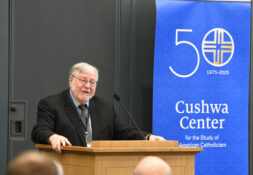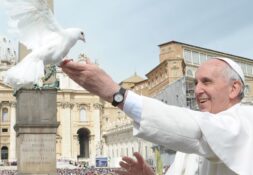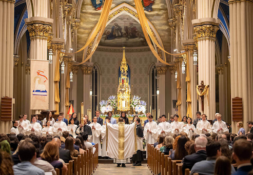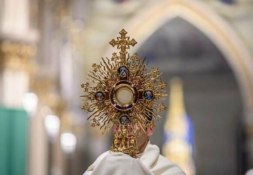The canonization of Pope St. Paul VI
Pope Paul VI was canonized by Pope Francis alongside six other new saints in Vatican City on October 14. His papacy has had a lasting and meaningful effect on the Church, especially through his participation in Vatican II and the encyclical Humanae Vitae.
Pope St. Paul VI was born Giovanni Battista Montini in northern Italy in 1897. He entered the seminary in 1916 and was ordained in 1920. He pursued studies in literature, philosophy, and canon law before working within the Vatican as a diplomat, serving in the Roman Curia from 1924 until his appointment as archbishop of Milan in 1954. Montini worked for the Vatican Secretariat of State during World War II, responding to thousands of requests for prayers and aid and organizing relief efforts for refugees.
As archbishop of Milan, Montini embraced a very personal and evangelical approach to his ministry. His efforts centered around preaching the Gospel across the city and advocating for the poor. He encouraged priests, bishops, cardinals, and the laity to share their Catholic faith with an increasingly secularized society outside of the normal bounds of the Church—in offices, schools, factories, and beyond.
In 1958 Montini was elevated to the cardinalate by Pope St. John XXIII and participated in the meetings and discussions of the Second Vatican Council. Following the death of Pope St. John XXIII in 1963, Montini was elected pope by the conclave of cardinals. Choosing the name Paul VI, he reconvened Vatican II, which had ceased upon his predecessor’s death.
Pope St. Paul VI carried into his papacy the passion for evangelization that he displayed during his time as a cardinal by stressing the missionary call of the Church. He authored the apostolic exhortation Evangelii Nuntiandi in 1975 to challenge Catholics to boldly proclaim Christ’s name and embrace their role as disciples in transforming the culture.
Paul VI modeled the boldness he encouraged in the faithful by traveling all over the world. Becoming the first pontiff to visit six continents, he was dubbed “the Pilgrim Pope.” He also became the first pope to visit the Western Hemisphere when he traveled to the United States in 1965, celebrating Mass in Yankee Stadium and addressing the United Nations, and journeyed to Columbia in 1968, where he participated in the 39th International Eucharistic Congress.
Pope St. Paul VI’s 1968 encyclical Humanae Vitae is seen as one of his most lasting and well known, albeit controversial, contributions to the Church. In this encyclical, penned at the peak of the Sexual Revolution, he explained the Church’s counter-cultural teaching on marriage, and necessarily, its opposition to contraception and abortion because they violate the procreative nature of marriage. Humanae Vitae, celebrating its 50th anniversary this year, has had a continual impact by inspiring the promotion of Natural Family Planning and an increased awareness of women’s health in building a Culture of Life. Through the work of the Paul VI Institute for the Study of Human Reproduction, founded to “answer the call for reproductive health care that fully respects life,” he continues to serve as a powerful symbol of pro-life dedication.
Pope St. Paul VI’s legacy as a staunch advocate for the dignity of the unborn is even seen in his canonization process. After his death in 1978, his cause for canonization was opened in 1993 by Pope St. John Paul II. His beatification occurred after a mother prayed for his intercession when she discovered her unborn son had serious health issues that could lead to brain damage and was advised to have an abortion. Her son, though, was born without any health problems and his complication-free birth was deemed a miracle. The second miracle attributed to Pope St. Paul VI’s intercession, causing his canonization, also involved a pregnant mother, who doctors likewise recommended receive an abortion. She had been diagnosed with an illness that threatened both her life and her unborn daughter’s, but the mother prayed to Pope St. Paul VI for his intercession and delivered a healthy baby girl.
At a time when the Church is rife in division and controversy, it can be easy to only focus on or ignore the areas one finds most or least palatable in Pope St. Paul VI’s legacy, namely his outreach to the poor, implementation of the liturgy reforms of Vatican II, Humanae Vitae, or his many other accomplishments. However, I think this approach does a disservice to the Church and neglects his status as a saint in heaven and therefore his role as an exemplar of “heroic virtue,” which is a necessity for an individual’s canonization process to begin.
Thus, as a student, I want to focus on emulating Pope St. Paul VI’s heroic virtue in my own striving for sanctity and would encourage others to do so as well. It’s so easy to compartmentalize the faith into solely doctrine or works and relegate it to merely a part of our lives. To combat this, we can follow this new saint’s example and, to borrow from Pope Francis’ homily at the canonization, spend our lives for Christ’s Gospel. This can look like anything from advocating for a Culture of Life to serving the poor and sharing the joy of the faith with a non-Catholic friend to a myriad of other endeavors. But no matter what they are, these actions cannot be grounded in anything other than Christ.
Pope St. Paul VI reminds us that holiness is attainable, but not on our own – “holiness is within everyone’s reach” and depends on not just our own good will, but the grace of God.
Mackenzie Kraker is a senior studying biochemistry and theology. She hiked 12 miles and walked a half-marathon over fall break and was filled with joy by her “heroic” FitBit step count. To share in her joy or discuss her favorite topic of heroic virtue, contact her at mkraker@nd.edu.






Leave a Reply